How to Play Chinese Mahjong
Already know the basics? Check out the scoring rules page.
What is Mahjong?
Mahjong is a strategy-based tabletop game that involves the collection of Mahjong tiles. The goal of the game is to successfully assemble a valid pattern of pieces. The game combines skill, strategy and luck which makes it a popular gambling game.
Mahjong is a 4-player game and has numerous variations played across China, Japan and South Korea. The All-China Sports Federation established an international standard of rules and scoring criteria known as Competition Mahjong or National Standard Mahjong. While many households play with their own rules, most official tournaments play exclusively with this standardized ruleset.
Definitions
- Wall - Before the start of a round, all tiles are randomly shuffled and arranged into a square referred to as the wall. Typically dice is rolled to decide where you begin drawing tiles off of the wall.
- Round - A round of Mahjong starts when the tiles are shuffled and assembled into the wall and ends when a player declares a win or no more tiles are left to draw.
- Hand - At the start of each round, each player is dealt tiles which form their hand. Each player can only see the tiles in their own hand, and not the tiles of others.
- Prevalent wind - During a round of Mahjong, one wind (starting with the East wind) is referred to as the prevalent wind. Some rulesets will reward players for collecting the prevalent wind.
- Seat wind - Each player is initially assigned a seat wind. A player's Seat wind doesn't change during a session of Mahjong. Some rulesets will reward players for collecting their seat wind.
Mahjong Tiles
Mahjong tiles can be broadly categorized into three types: Suits, Honors and Flowers/Seasons. Suit tiles are gameplay tiles with a numeric value from 1-9, Honor tiles are gameplay tiles with no numeric value, and Flower/Season tiles are gambling tiles that only impact the scoring of a hand.
- Suit - Circle (1-9)


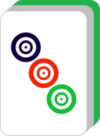
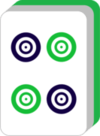
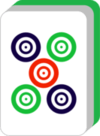
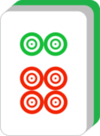
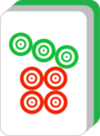
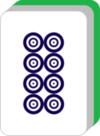
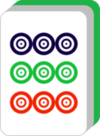
- Suit - Bamboo (1-9)

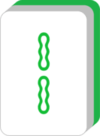
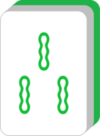
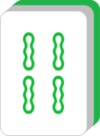
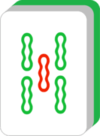
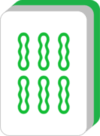
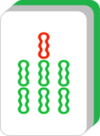

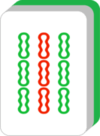
- Suit - Character (1-9)
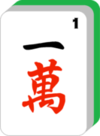
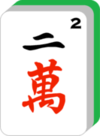
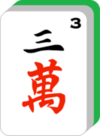
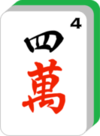
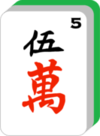
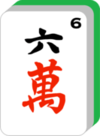
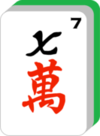
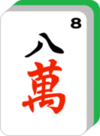
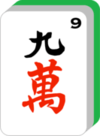
- Honor - Wind (East, South, West, North)
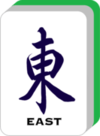
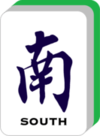
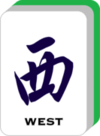
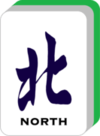
- Honor - Dragon (Green, Red, White)
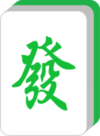
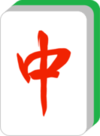

- Flower/Season
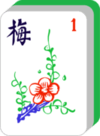
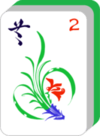
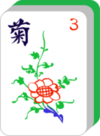
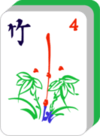
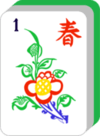
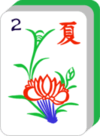
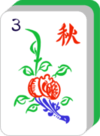
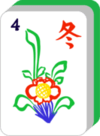
There are 4 copies of each Suit (Circle, Bamboo, Character) and Honor (Wind, Dragon) and one of each Flower/Season tile (4 Flowers, 4 Seasons) for a total of 144 tiles.
The Flower/Season tiles generally have no impact on the outcome of the game. They can be publicly declared from your hand which lets you set them aside and replace them with a tile from the back of the wall. While they have no direct impact on the game, they can affect the number of points you get from winning a hand. Note that it is strategically advantageous to declare your flowers as soon as you get them, as you can't win with them in your hand and you would want to know what tile you draw from the back.
Mahjong Groups
The 4 types of Mahjong groups are:
- Chow - A Chow is formed from 3 consecutive tiles of the same suit.









- Pung - A Pung is formed from 3 identical tiles. This can be of either suit tiles or honor tiles.












- Kong - A Kong is formed from 4 identical tiles. This can be of either suit or honor tiles. When a kong is declared, the player draws a replacement tile from the back of the wall.












- Pair - A Pair is formed from 2 identical tiles. This can be of either suit tiles or honor tiles.










Goal of Mahjong
In the game of Mahjong, a player wins by assembling pieces that can be used to form 4 triples (Chow, Pung, Kong) and a pair. A player can either assemble these groups by drawing pieces from the wall and discarding unwanted pieces from their hand, or by claiming another player's discard to publicly form a group. Different rulesets have different conditions on the types of groups required for a winning a hand. For instance, competition Mahjong requires that the hand be worth at least 8 points.















Depending on the ruleset, there are also specialty hands composed of specific pieces that are also considered a winning hand (Seven Pairs, Thirteen Orphans, etc). Most of these specialty hands are rare and are thus worth more points.




























Initial Setup
The 4 players are initially arranged around the four sides of a table. One player is randomly assigned East (a dice is rolled) as their seat wind, and the remaining winds, South, West, North are assigned counter-clockwise (inverse-compass) from the North player.
Each player is dealt 13 tiles from the wall (shuffled stack of tiles) with the exception of the East player who is dealt a 14th tile. Each player can only see their own tiles and not the tiles in the other players' hands.



























16 tiles are also removed from the wall and are set aside as the "back" of the wall. These tiles cannot be drawn conventionally and can only be drawn from Kongs or Flowers.
At the very start of the round, each player, starting from the North player, gets to declare flowers from theirs hands. For each tile a player declares, they draw a replacement tile from the back of the wall. Once all players have finished declaring flowers, the game starts on the North player's turn.
Turn Actions
On your turn, you have the option of making certain turn actions. These actions do not end your turn.
- Public Kong - If you have a public Pung, also known as a melded Pung, of a specific tile and you have the 4th copy of that tile in your hand, you can declare a public Kong and add the 4th tile to promote the Pung to a Kong. Then you draw an additional piece off of the back of the wall.




- Private Kong - If you have 4 copies of a tile in your hand, you may declare a Private Kong of that piece and set those pieces aside and facedown. Then you draw an additional piece off of the back of the wall.




- Flower/Season - If you have a flower/season tile in your hand, you can declare the flower. The flower tile is set aside and you draw a replacement tile from the back of the wall.








Discard Actions
Once another player discards a tile, you have the option of publicly claiming the discarded tile to complete a triple or finish your hand. Once you claim a discarded tile, the corresponding tiles that form the triple are removed from your hand and set aside with the claimed tile. This group can not be dismantled or discarded.
Note that only one player may claim a single discarded tile. If multiple players attempt to claim a discarded tile, the action with the highest priority is resolved. The discard actions in decreasing priority are:
- Win - If the discarded tile completes your hand, you can declare victory and show the pieces in your hand. Your hand is then scored.
- Kong - If any player discards a tile that completes a Kong in your hand, you can declare a Kong and reveal three copies of the discarded tile from your hand. The discarded tile and the three revealed tiles are added as a Kong to your groups. You then draw a tile from the back of the wall.




- Pung - If any player discards a tile that completes a Pung in your hand, you can declare a Pung and reveal two copies of the discarded tile from your hand. The discarded tile and the two revealed tiles are added as a Pung to your groups.



- Chow - If the player immediately before you discards a tiles that completes a Chow in your hand, you can declare a Chow and reveal the two tiles in your hand that form the Chow. The discarded tile and the two revealed tiles are added as a Chow to your groups.



Note that if multiple players declare a Win on a single discard, the player who is first counter-clockwise from the discarding player takes priority and wins.
Gameplay
At the start of your turn, you draw a tile from the wall and you add it to your hand. Depending on the pieces in your hand and your publicly declared sets, you have the option of making turn actions. Once you no longer wish to make any actions, you end your turn by choosing one of the tiles in your hand and discarding it face-up. Other players will then have the option of passing or making a discard action. If no one makes a discard action, the next player counter-clockwise draws a tile and starts his turn.
The players repeat this process until a player manages to assemble a winning hand. Once a player declares a winning hand, the round ends and the winning player's hand is shown and scored.
Round End
The round ends once a player has declared a winning hand or there are no more tiles in the front of the wall. If a player has won, they take points from the rest of the players depending on the ruleset specified. If there are no more tiles, then the round ends and no points are exchanged.
Once the round ends, the tiles are all shuffled and redealt. The starting player rotates in clockwise order (East - South - West - North) and is dealt an additional 14th tile. If the starting player is the East player, the prevalent wind rotates in clockwise order (East - South - West - North).
Game End
Note that generally there is no specified end to a game of Mahjong as you can continue to play and rotate winds indefinitely. Players can thus choose to stop whenever they wish between rounds. However, for the purposes of tournaments, you can "end" a game once the players have finished playing a certain number of rounds, or until a player has reached a target score.
